Figure 13.2. Model of horizontal gene transfer as facilitated by the gonococcal T4SS.
The core outer membrane complex of the gonococcal T4SS is made of TraK, TraB, and TraV. Insertion into the membrane is thought to depend on the cutting of the peptidoglycan layer by AtlA, and periplasmic proteins such as Yag, TraW, TraF, TraH, TrbC, and LtgX are likely involved in assembly of the apparatus. Transport of DNA and incorporation into the recipient cell is thought to occur as follows: (1) TraI nicks the chromosome at the oriT and is localized to the secretion system with the help of the partitioning proteins ParA and ParB. (2) The TraI-ssDNA complex is transported out of the cell, facilitated by the coupling protein TraD and the ATPase TraC. (3) Once outside the cell, the ssDNA may bind ComP on the type IV pilus of a neighboring cell (shown as orange, where the major pilin protein is shown as yellow), (4) Retraction of the pilus brings the DNA into the recipient periplasm, where it is then transported across the inner membrane by the competence (Com) system. (5) Finally, the DNA is incorporated into the genome by homologous recombination.

